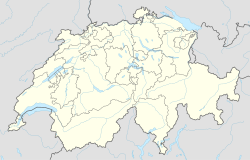Tägermoos
| Tägermoos | ||
|---|---|---|
|
||
 |
||
| Coordinates: 47°40′N 9°09′E / 47.66°N 9.15°E | ||
| Country | Switzerland | |
| Canton | Thurgau | |
| Region | Kreuzlingen | |
| Municipality | Tägerwilen | |
| Area | ||
| • Total | 1.541401 km2 (0.595138 sq mi) | |
| Elevation | 397 m (1,302 ft) | |
| Population (26 May 2009) | ||
| • Total | 20 | |
| • Density | 13/km2 (34/sq mi) | |
| Website | www.taegerwilen.ch | |
The Tägermoos is an area of 1.54 km² in Thurgau, Switzerland, wedged between the outskirts of the German city of Constance and the core village the Swiss municipality Tägerwilen. It lies on the south bank of the Seerhein. In the east, it borders the district Paradies of Constance. In the south-east, it borders the district Emmishofen of the municipality of Kreuzlingen.
The remarkable status of Tägermoos was fixed in 1831 by a treaty which is still in force today. Under this treaty, the area is part of Switzerland at the state level and part of the Swiss municipality of Tägerwilen. However, certain administrative tasks are exercised by the German city of Constance, in accordance with Thurgau municipal law. Other tasks are exercised by the authorities of Tägerwilen. In particular, land survey is the responsibility of Constance, making Tägermoos a of the city of Constance.
The City of Constance legally owns about two-thirds of the land; the rest is held by Swiss authorities and private citizens. It was once a marshy commons, but has since been drained and is now mostly used for agriculture, primarily vegetable production and allotments. At the Eastern edge, there are two border crossings, the larger Tägermoos crossing and the smaller Gottlieber Zoll.
During the Early Middle Ages, the Tägermoos belonged to the possession in Thurgau of the Diocese of Constance, the so-called Bischofshöri. Bishop Hermann I of Arbon (term 1138-1165), donated the land to the Scots Abbey St. James in Paradies, which had been founded in 1142. In 1293, the City Council of Constance purchased the Tägermoos from the Abbey, for use as a commons. It was used for cattle essentially unchanged from the 13th century until its privatisation in 1800.
...
Wikipedia


